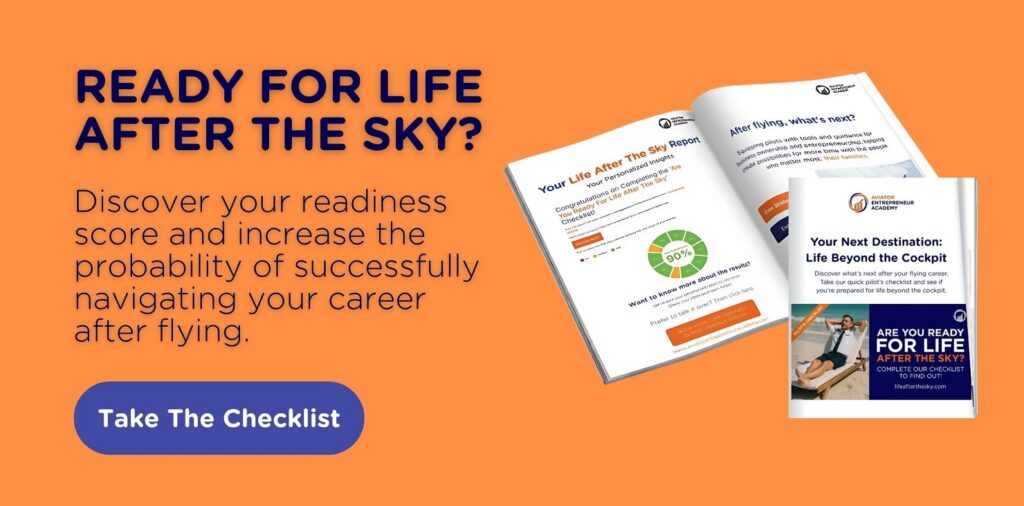We’re living in a two-system economy.
On one side is the old world of salaries and contracts, where pilot paychecks lose ground against rising costs. And on the other is the digital economy, where value grows, scales, and compounds.
As pilots, we’re trained to operate in complex systems, adapt quickly, and think globally. That makes us perfectly positioned to cross over.
The only question now is: will we stay stuck in the system that’s holding us back, or start building in the one that can set us free?
Key Takeaways
- Two-System Economy: The world now runs on two systems: the Classic, tied to salaries and geography, and the New Generation, built on assets and networks.
- Pilots’ Unique Edge: Pilots already think globally, manage risk, and master complex systems. These skills give us a natural advantage in the digital economy.
- Bridging the Gap: Transitioning doesn’t happen overnight; it starts with awareness, learning, small tests, and gradual scaling.
- Scaling Smartly: Scaling means reinvesting in what works, automating tasks, and leveraging networks. This turns side projects into lasting income streams beyond salary.

What Is the Two-System Economy?
The world isn’t running on one economy anymore. It’s really two different systems operating side by side.
In the Classic system, most people still depend on a salary or paycheck. Their opportunities are tied to geography, seniority, and traditional career paths. Technology here feels like a threat because it replaces jobs.
Alternatively, in the New Generation system, income comes from assets, networks, and digital platforms. It’s not about where you live or how many years you’ve worked. It’s about the value you create and how widely you can share it.
As Warren Buffett famously said:
“If you don’t find a way to make money while you sleep, you will work until you die.”
Two-System Reality of Aviation
Pilots go through the same economic divide.
In Classic aviation, most of us follow the well-known path: airline contracts, seniority lists, and pay scales. These give us stability, but they also lock us into a system that moves slowly. Career growth often depends more on years of service than on innovation.
Despite Boeing’s forecast of 649,000 new pilots, automation pressures remain strong in regional and cargo operations.
If that happens, pilots will face fewer employers, fewer choices, and less negotiating power.
On the other hand, in New Generation aviation, the opportunities appear completely different. Pilots are using their expertise to build businesses beyond the cockpit. Others are consulting on safety, operations, or technology for international carriers.
Rather than being tied to one employer and one crew base, pilots are now taking the leap of faith, which helps them reach global audiences from day one.
Why Pilots Have Unfair Advantages in the New System
Most people entering the new digital economy are starting from zero. They need to learn how to think globally, manage risk, or stay disciplined when things get tough. But as pilots, these skills are second nature.
1. Global Mindset
Pilots don’t see the world as separate markets; they see it as one interconnected system. Flying across borders every week gives us an instinctive feel for cultures, currencies, and opportunities. While others hesitate to “go international,” for us, it’s already a normal part of our lives.
2. Systems Integration
Modern aviation is about managing complex systems: weather, ATC, automation, and human factors all at once. The digital economy is no different. Success often comes from integrating technology, people, and processes. Where others get overwhelmed, pilots see patterns and solutions.
3. Risk Management
In the cockpit, we don’t eliminate risk; we manage it. We assess, prepare, and execute under uncertainty. That mindset is gold in investing and entrepreneurship. Most people freeze when conditions shift. However, pilots are already trained to act decisively with limited information.
4. Network Effects
Aviation teaches us that small actions have a ripple effect. A flight plan checked correctly can mean a safe flight across continents. In the digital world, the same principle applies: a single online course, a YouTube video, or a business connection can reach thousands and scale far beyond us.
The Bridging Strategy: How To Move From Classic to New Gen?
Most of us won’t jump straight from flying to building a digital or business empire overnight. That’s not how transitions work. Instead, it’s about creating a bridge between the two systems.
Here’s how you can do it:
Phase 1: Awareness
The first step is simply recognizing that the new generation economy exists. Many pilots still believe airline contracts, seniority, and pensions will secure their future, but data shows otherwise.
According to surveys, the average airline pilot salary increased by just 12% year-over-year over the last decade, while housing prices rose by more than 60% globally. If we don’t acknowledge this gap, we’ll never prepare for what’s coming.
Awareness means seeing the opportunities in digital aviation training, consulting, or remote investing that others are already capitalizing on.
Phase 2: Learning
Once we identify the opportunities, the next step is to acquire skills during downtime. We already study complex systems for a living, so learning digital tools or business fundamentals is well within reach.
You can use platforms like Coursera, Udemy and AEA to find courses in finance, marketing, and entrepreneurship
For us, this isn’t about staying at an airline; it’s about building a future where we’re in control.
Phase 3: Testing
Being in the cockpit teaches us to trust checklists and test systems before we rely on them. The same principle applies here. Instead of betting everything on a single idea, we start with small projects, such as a rental property in a growing market or a digital course sharing aviation knowledge.
These “test flights” provide us with real-world feedback without incurring major risk.
Jeff Bezos once said, “Our success at Amazon is a function of how many experiments we do per year, per month, per week, per day.” For pilots, testing small ventures is the safest way to find the right fit.
Phase 4: Scaling
Once you know what works, the goal is to gradually scale. That means shifting more of our time, energy, and resources from the old system (pure salary) to the new system (assets, business, digital income).
The easiest way to scale is to build on the projects that showed promise during testing. If your digital aviation course gained traction, expand it with advanced modules.
Similarly, if you have invested in assets, start reinvesting the returns into new opportunities instead of letting them sit idle.
Make sure to document what you’re working on, automate what you can, and delegate tasks that don’t require your direct involvement.
Ready to Cross Into the New System?
If you’re still unsure or maybe even scared about making the shift, that’s normal. Most pilots are. But the risk isn’t in trying, it’s in waiting too long.
To help you, we’ve created the Life After The Sky Checklist.
It shows exactly where you stand today, what gaps you need to fill, and the steps to move toward financial independence.
Don’t stay grounded in a system that no longer serves you!
Invitation to Join Our FREE Strategy Session
Most pilots are one honest conversation away from clarity. This is that conversation.
Complete our “Life After the Sky” checklist, then join me for a FREE 15-minute “Strategy Session” via Zoom.
This session has been created for pilots who want to take ownership of what comes next.
Those who want action, not just to talk about it.
In just 15 minutes, we’ll:
- Review your checklist results
- Identify the one obstacle holding back your reinvention
- Translate your checklist results into a clear starting point
Start your pre-flight assessment for the next chapter of your journey by Booking your free strategy session here!



